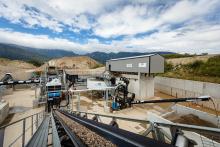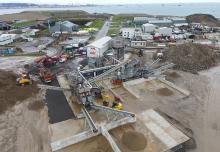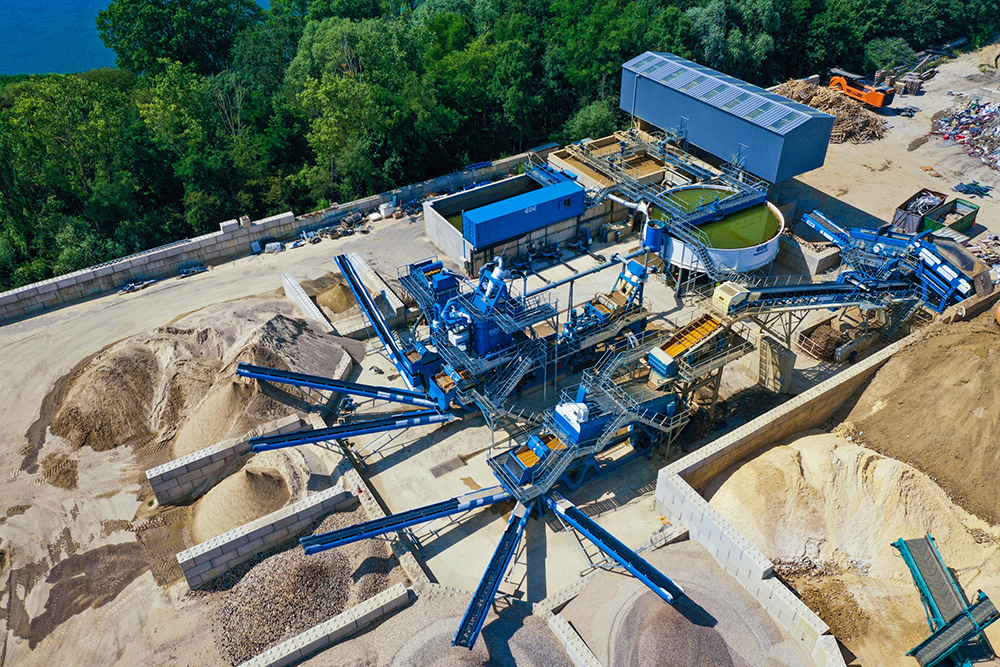
French waste management company Sodextra has invested in a bespoke construction, demolition and excavation (CD&E) waste recycling plant from CDE, marking its first venture into the wet processing of materials and enabling the recovery of up to 70% of incoming inert CD&E waste. The new plant is currently processing material at a rate of 135 tonnes per hour (tph), producing six sand and aggregate products, opening new markets for the family-owned and -operated business.
Based along the Plateau de Saclay, 15km south of Paris, Sodextra operates a major construction waste recycling treatment facility, situated on an eight-hectare site, that supports construction professionals to deposit and process waste and rubble in the Paris region.
Established in 1975, the business has, for over 45 years, facilitated the diversion of significant tonnages of CD&E waste from landfill, assisting in the recovery of a variety of high-value construction materials, including recycled sand and aggregate products, and returning them to the sector for use in major public works and infrastructure projects. Its primary market sectors are the recovery of deconstruction concrete, the recovery and treatment of industrial waste and the sale of ready-mixed concrete.
Currently, the third-generation family business recovers one million tonnes of material from waste per year, a substantial volume it hopes to increase further because of its latest investment in CDE technology which is now enabling the recovery of inert soil.
Sacha Bottemanne, directeur général of Sodextra S.A. and son of its owner, Christian Bottemanne, said the company’s biggest challenge was treating highly variable waste coming into the facility.
“We used to screen the soil and we could recover about 20% of the pebbles which were reused in our crushing plant. The remaining 80% was dumped.

“We realised that in this 80% there were still materials with high added-value which today, with the CDE installation, we can recover.”
Based on the analysis of the soil from around the Saclay plateau, CDE’s business development manager for France, Marc Sopransi, quickly realised the challenge presented by the processing of the very heterogeneous and heavily clay-bound material.
“Sodextra approached us to find out how to further recover their inert soil, to find a way to recover more sand and gravel and turn them into high value-added construction materials.”
He said going from “a wide spectrum of multiple raw sand feeds to be processed to a regular spectrum, as narrow and as stable as possible, of clean 0-4mm sand, was at the heart of the problem.”
To demonstrate the potential for CDE technology to support Sodextra to recover high-grade and high-value products from its waste, the Sodextra team was invited to a CDE reference site in Germany to see the technology in action.
“We saw the materials that went into these installations, which were of very poor quality, very sticky and full of diverse contaminants such as plastics or roots…we really saw the process and the quality of the materials coming out. That’s why we decided to go with CDE.”
Samples of feed material to be processed by the plant were tested and analysed by CDE process engineers in its laboratory to determine the reclamation potential of the incoming waste stream and the quality of its output.
The plant incorporates a combination of CDE-signature modular technologies, including the AggMax modular logwasher setup for scrubbing and sizing and EvoWash sand classification and dewatering systems with integrated patented technologies, including CDE’s Infinity Screen and Counter Flow Classification Unit (CFCU) for density separation, which efficiently separates materials of differing specific gravity to maximise the quality and value of feed stock.
Commenting on sand treatment, Sopransi said the solution engineered for Sodextra is unique.
“It consists of a first cyclone pass, attrition cells, a second cyclone pass, a hydraulic classifier, and a third cyclone pass with two major classification points placed at 250 microns and 2mm. This sand treatment provides a dynamic response to a dynamic problem.
“The type of sand treatment in this application is a first in Europe,” he adds.
“Its originality lies in the fact that the solution uses technologies usually used in the treatment of industrial sands.”
The solution designed for Sodextra not only allows for the recycling of CD&E waste, but it also maximises water efficiency with CDE’s AquaCycle, a single, compact, and user-friendly unit that can be applied to high and low tonnages across many markets.
An alternative to water extraction and the costly process of pumping water to the plant, CDE’s AquaCycle is a highly efficient water management solution that minimises costly water consumption by ensuring up to 90% of process water is recycled for immediate recirculation.
Delivering competitive advantage to its customers, CDE’s AquaCycle accelerates return on investment by maximising production efficiency, minimising the loss of valuable fines, and reducing water and energy costs.
After feed material has been washed and classified, the wastewater is sent to the AquaCycle thickener system. Here, a small amount of polyelectrolyte flocculant is added to the water via an automatic dosing station which forces fine particles to settle on the bottom of the thickener tank. The clean water on the top overflows the weir and is stored in the AquaStore tank before being re-circulated around the plant. The result is a highly efficient water recycling system that requires only a 10% supply of top-up water.
Waste sludge is discharged into a buffer tank where agitators in constant rotation ensure the material does not settle and solidify at the bottom.
For Sodextra, the high quantity of sludge generated by the raw material process meant that the use of a filter press was necessary to avoid settling ponds. Its integration also facilitated the recycling of even more water from the process. Filtrates recovered and redirected to the company’s new AquaCycle have enabled Sodextra to achieve a water recycling rate of approximately 96%, significantly reducing the need for top-up water supplies.
The plant is processing material that was once destined for landfill and producing a range of products, including three different sands: a fine sand 0-250um, a 0-2mm and a 0-4mm; and three different aggregates: a 4-10mm, a 10-20mm & a +20mm aggregate, all ready for use in construction projects in the Paris region.
“Our CDE installation produces high-quality aggregates that we now call ‘eco-gravel’ or ‘eco-sand’. These are very high-quality materials that are similar to natural materials,” explains Bottemanne.
A filter cake product from the integrated CDE Filter Press can also be reused as a waterproofing layer or for pipe bedding and landfill capping.
“Today, the CDE installation allows us to recover 70% of the waste and to create new materials that are reused in construction sites throughout Greater Paris.”
Bottemanne said Sodextra was established when his grandfather recognised the need for C&D recycling in the Greater Paris area.
“Sustainability is in the very fabric of our business. It was founded on the same principles it operates today and we remain committed to closing the loop.
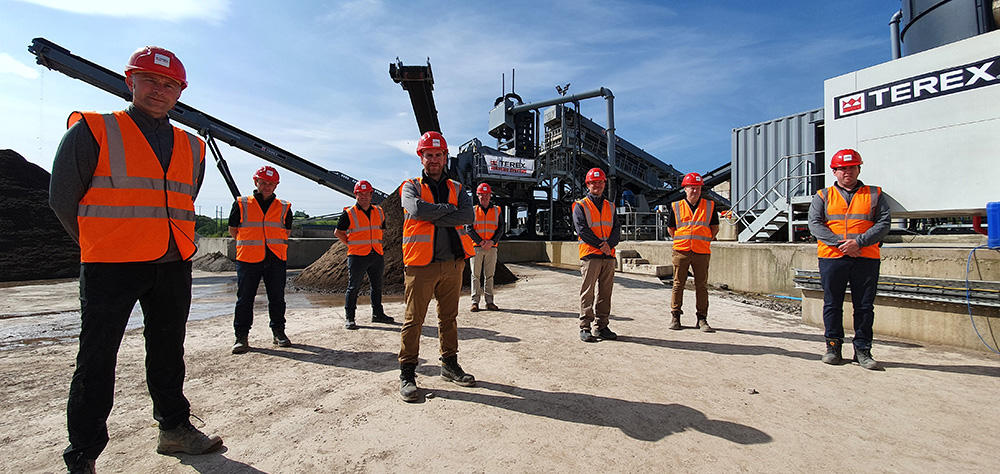
“Our customers are increasingly concerned about the environment. With these new materials, we are contributing to the circular economy and to sustainable development.”
Sodextra’s new plant is the culmination of over two years of site audits, lab-based research on materials and collaborative design workshops, whereby the CDE team co-created the engineered-to-order solution with the Sodextra team.
“Between the beginning of the project to the final phase, we were in touch with our ProMan who followed us throughout, who supported us and who also guided us,” explains Bottemanne.
“Today the relationship we have with CDE is going very well because we’ve really entered into a partnership.”
Sopransi said the plant has now been operational for a full year and has successfully met all Sodextra’s objectives.
“To further revalorise inert soil, to provide aggregates eligible for concrete specifications, and to realise an installation that took the minimum of space.”
He added CDE is committed to the region and has recently expanded its CustomCare team locally, which provides after-sales support to guarantee customers get the maximum performance from their CDE equipment.
“CDE has set up a support and services engineer in France who will be available to provide responsive, boots-on-the-ground support to our customers in the region, including Sodextra as they continue to provide a valuable service to the local construction industry.”
Terex Washing Systems hosted a highly successful Virtual End-to-End Washing Solution Showcase, which was broadcast live from a Keohane Readymix site in Co. Cork, Ireland.
The event showcased a recently installed full turnkey solution for washing and classifying to produce specification sand and aggregate for Keohane Readymix. A team of washing experts explained the different pieces of equipment that came together to form the bespoke plant and outlined how, when combined, this washing system is proving to be a success for the customer.
Keohane Readymix, founded in 1979 by Paddy Keohane, is now a third-generation company serving a broad customer base throughout Ireland with a range of concrete products, sand and aggregates. The washing solution is situated at its site at Brinny, Co. Cork, which feeds sand and gravel product to other Keohane Readymix sites in the region.
Viewers were taken on a journey from the start of the design process, which was determining the nature of the material to be processed. Johnston Patterson, applications manager for Terex Washing Systems explained: “The material is a natural sand and gravel deposit which, while fairly free-flowing, can get sticky and has some clay through it, as well as some organics, sticks and roots. The feed material is 60/40 sand to gravel and predominantly minus 150mm, but it can be up to 300-400mm. The typical % passing 63micron is around 10%.”
To get started with the process of designing the new plant, Keohane Readymix provided a sample of its material and instructed the team on what products they would like to make from it. This material was analysed in a Terex Washing Systems lab and from this, the team was able to propose a bespoke plant that would meet their needs.
Viewers were then taken through the operational site, learning about key features of each piece of equipment that make up the full plant—including an H30 Feed Hopper, AggreSand 206, AggreScrub 150, a deep cone thickener, a floc dosing unit, a central control panel and stockpiling conveyors. Viewers also saw how the plant uniquely features a freshwater tank buried beneath the machine to reduce its overall footprint.
This in-depth look at the inner workings of the entire wash plant allowed viewers to see the years of experience that have gone into the engineering of Terex Washing Systems. All aspects including the design, manufacturing and installation of the system were covered by Terex Washing Systems, which allowed for a truly integrated system.
Barry McMenamin, business line director at Terex Washing Systems, explains: “Our team worked with the Keohane business in assessing the application and designing the plant that specifically suits their needs. They also helped to design the civil concrete works that the plant is seated on, a very unique and innovative feature here is the fact that the freshwater tank is beneath the machine, within the plinth itself, demonstrating the extent to which this plant is tailored to the requests from the customer.”
Viewers also heard directly from Gavin Twohig, operations manager of Keohane Readymix, on how the plant is performing. Speaking of his experience of the plant, Gavin said, “We’ve been very happy with the output of the plant. We had decided to put in a log washer system because of the cleanliness of the material. With the log washer on site, it’s doing an excellent job and the chips are very clean”.
Following the showcase, those watching online were able to take part in a question-and-answer session with the washing experts on site. Questions ranged from queries about levels of accessibility for maintenance to more specific water management inquiries. Attendees were also able to ask about the potential for a filter press on a site where water is limited (similar to the situation at Keohane’s Brinny site) as well as ask about how a plant could be tailored for their site.
The digital format of this live event enabled Terex Washing Systems to bring one of their modular washing systems into the homes and workplaces of hundreds of attendees in a single day.
McMenamin explains: “In today’s world, where our customers are not able to be with us in person, we wanted to provide a ‘walk around’ of this operational site in the real world; explain the features of the equipment and show it in operation. We believe this is the best way to give our customers a complete understanding of how we can provide an end-to-end solution that is tailored to their needs. The live event was a huge success—to be able to showcase a system that we’re massively proud of to such a large audience has been fantastic.
“No such installation or project would be complete without investment from a customer, and we are glad that Keohanes chose Terex Washing Systems as a partner for this project. We’d like to extend our appreciation to all at Keohane Readymix for enabling us to showcase their plant to the world, live from their site.”
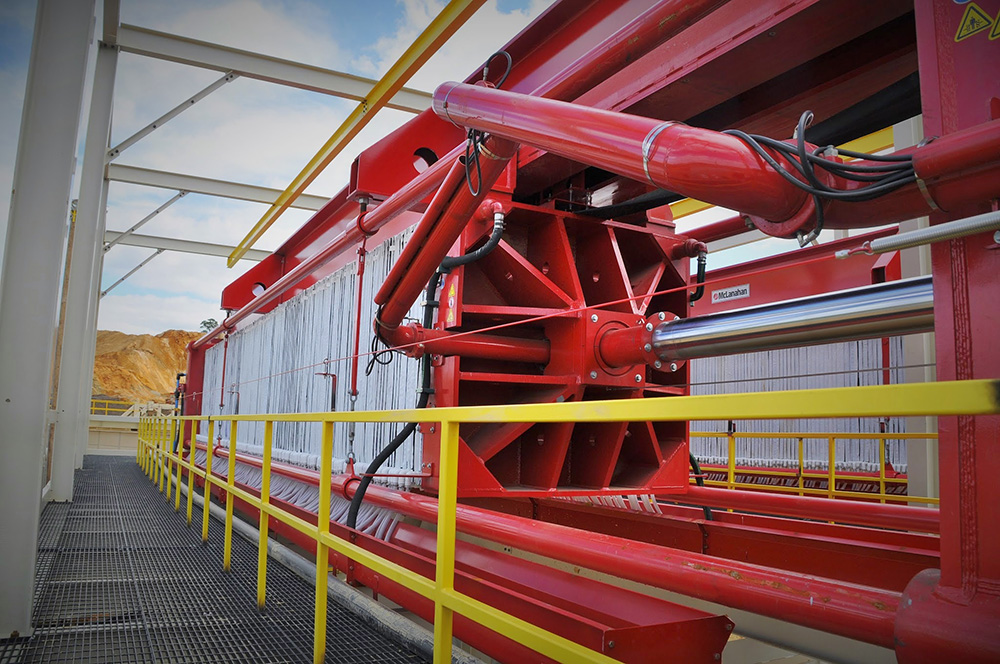
McLanahan, the U.S.-headquartered global supplier of engineered process solutions for the aggregate, mining, and agricultural industries, has outlined why filter presses are the best choice for settling pond elimination.
“The aggregate and mineral industries have historically used the simplest and cheapest dewatering technology to manage waste slurry tailings,” says a company spokesperson.
“These old methods include dumping directly into streams, rivers and lakes or using mining surfaces or underground quarries/pits for disposal.
“For a number of decades these industries have been pressured to eliminate older ways of waste dumping and look for more efficient waste management technologies.
“Initial improvement in tailings management technology involved creating ponds or large impoundment dams to hold the waste slurry for the life of the quarry or mine.”
McLanahan says that over the past decade or so, pressures to improve tailings management practices have increased further due to several factors, including stricter environmental regulations, rising operational costs, higher waste handling costs, increased water conservation requirements, catastrophic impoundment failures, the need for better risk mitigation, and physical space limitations for operational expansion.
The firm notes that leaders in the aggregate and mineral industries have started evaluating and investing in more efficient, cost-effective systems to dewater tailings. The systems include ultra-fines separation, slurry thickening and slurry dewatering equipment technologies.
The UFR (ultra fines recovery) and thickener equipment technologies separate and concentrate the waste materials, while the dewatering equipment recovers additional water from the waste stream and creates nearly dry solids.
McLanahan says plate filter presses, belt filter presses and centrifuges are competing dewatering equipment used in the aggregate and mineral industries today.
Centrifuge dewatering is a high-speed process that uses the force from the rapid rotation of a cylindrical bowl to separate wastewater solids from liquid.
The company spokesperson continues: “These dewatering devices work best with material that is more easily dewatered, has a larger particle size distribution and/or a low clay content, though they generally are not going to be as efficient as a filter press since they cannot generate the high-pressure dewatering forces of the latter.
“Centrifuges operate as continuous feed units that remove solids by a scroll conveyor and discharge liquid over the weir. The bowl is conical-shaped to help lift solids out of the liquid, allowing them to dry on an inclined surface before being discharged.
“Centrifuge equipment has high up-front investment cost and high operating cost. It is built to tight mechanical design specification to operate efficiently at very high rotational speeds.
“Operating costs are high due to high electrical power requirements, expensive replacement parts and the need to use dewatering chemicals.
“In addition, centrifuge operation requires skilled, experienced operators. Centrifuges have a reputation of high noise, high-speed vibrations and are subject to frequent wear issues.
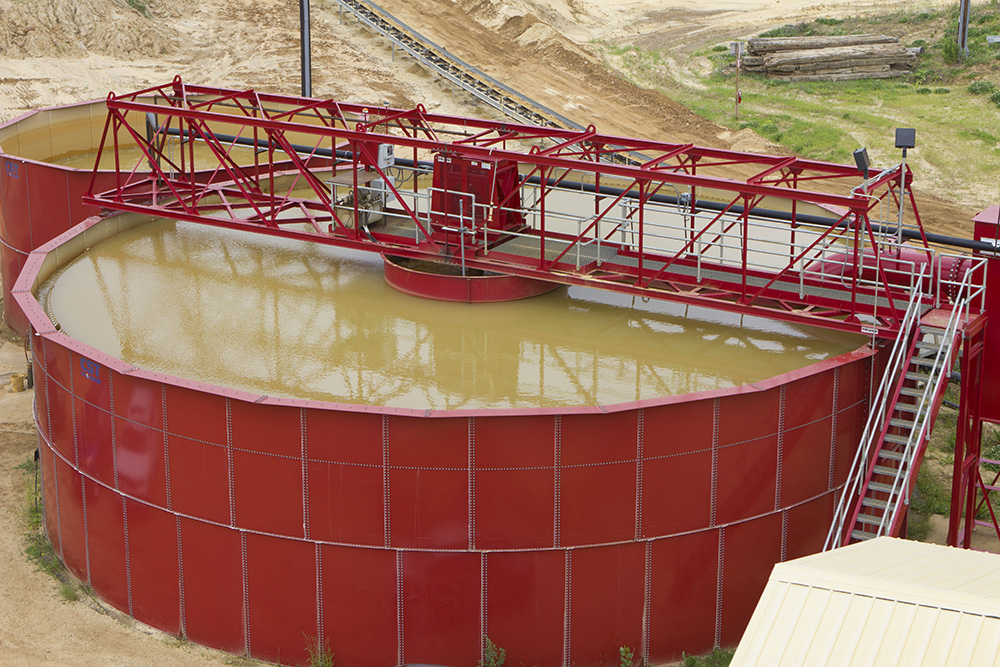
“Because centrifuges are smaller than filter presses, the footprint could be less than that of a large plate press depending on how many units are required.”
McLanahan highlights that belt filter presses are another type of equipment used to remove water from waste slurries to produce a non-liquid material referred to as a ‘cake’.
“In a belt filter press, the waste slurry is forced between two tensioned porous belts. As the belts pass over and under rollers of various diameters, the liquid is squeezed out of slurry while the solid cake material is retained between the belts. Increased pressure is created as the belt passes over rollers that decrease in diameter.”
McLanahan says there are many designs of belt filtration processes, but all incorporate the following basic features: polymer conditioning zone, gravity drainage zones, low-pressure squeezing zone, and high-pressure squeezing zones.
“Advanced designs provide a large filtration area, additional rollers, and variable belt speeds that can increase cake solids by 5%,” the company spokesperson says.
“The general mechanical components of a belt filter press include dewatering belts, rollers and bearings, belt tracking and tensioning system, controls and drives, and a belt washing system.
“Belt filter presses have low-to-medium initial capital cost, with a smaller footprint for installation.
“Operating costs tend to be high due to the need for a full-time operator and the use of chemical dewatering aids.
“Maintenance costs are also expensive due to belt and roller wear as well as failure from continuous movement of the tensioned belts between the rollers. Belts and roller bearings require frequent replacement, creating lower overall availability.
“Belt presses have a reputation of requiring frequent belt washing and are very sensitive to process variations.”
McLanahan says recessed plate filter presses are used to create a dewatered cake material by separating the liquid and solid materials in waste slurries.
The company explains that these filter presses are among the oldest types of dewatering devices and are commonly used in aggregate and mineral processing waste slurry applications.
“Typical recessed plate filter presses are composed of a heavy-duty support framework holding a series of polypropylene plates with concave surfaces on each side of the plate. Each plate is lined with a synthetic filter cloth. The plates are tightly clamped together with hydraulic pressure, creating a void space between the plate surfaces.
“A high-pressure slurry feed pump is used to force slurry material into the void spaces between the plates. The slurry solids are captured between the plates, while the liquid passes through the filter cloths mounted on the plate surfaces.
“When no additional slurry can be pumped into the filter press, the slurry feed pump is stopped and the plates are separated, allowing the cakes to fall by gravity out of the press.
“The up-front investment for a plate filter press can be high due to the size of the equipment and required support structure.”
Depending on the type and amount of material being dewatered, McLanahan notes that modern filter press equipment can be very big and require a large space for installation and operation. Common polypropylene plate sizes today can be up to 8 inches wide by 8 inches tall, with large filter presses holding up to 200 hundred plates.
The company spokesperson adds: “Plate filter press operating costs are low due to the requirement of only a part-time operator, lower wear parts cost and typically no need for chemical dewatering aids.
“Because the slurry material is captured completely between the filter plates, very high dewatering pressures (up to 225 psi or higher) can be applied to the slurry. The high dewatering pressures produce the highest cake solids concentration possible of any mechanical dewatering equipment.”
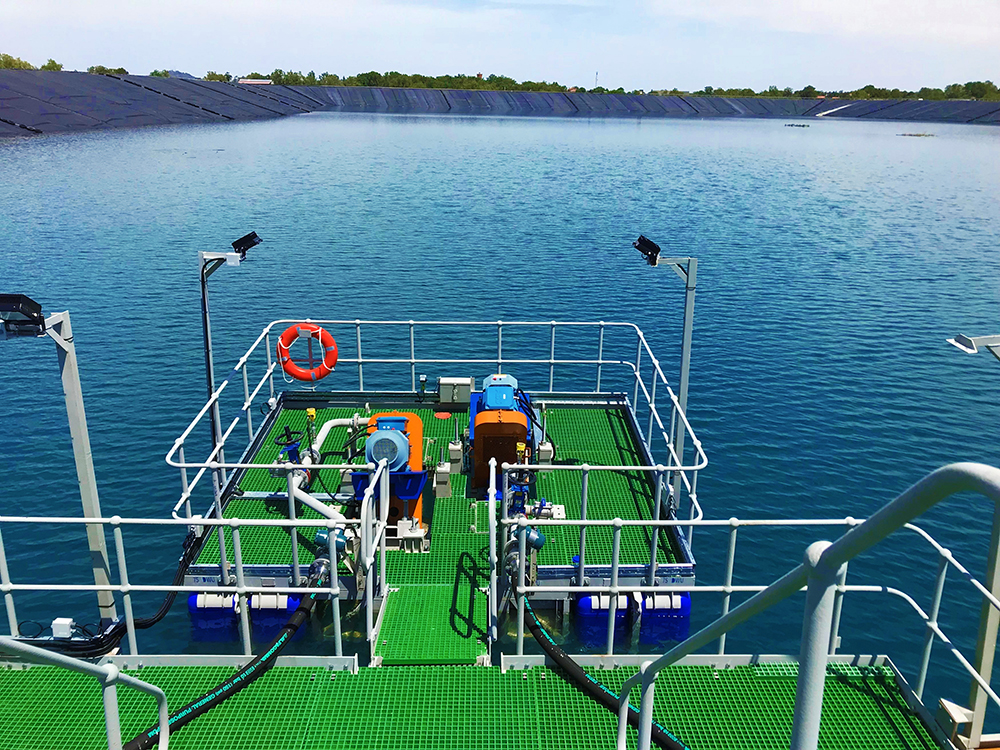
McLanahan says plate filter presses can also employ a second type of plate called a membrane plate. In this case, the plate has a flexible membrane surface made from polypropylene or other synthetic flexible material such as hard rubber.
The membrane can be thermally fused to the concave plate core, or the synthetic membrane’s edge can be embedded into the concave plate core in a small channel machined in the plate surfaces.
The same initial process is used in a membrane plate press, with a high-pressure slurry pump feeding the press to fill and dewater as much slurry as possible.
After the slurry feed pump is stopped and while the filter plates are still clamped together, the membrane surfaces are expanded using compressed air or water. This inflated membrane compresses the cake material, removing additional moisture to the lowest possible levels.
“No other dewatering process has shown to be more efficient at removing liquid from slurries as the plate filter press,” says the company spokesperson. “Additional benefits of plate filter presses include the highest amount of recovered water, the driest cakes, lowest operating cost, lower waste handling cost, [they] haul less water, and the most stable solid material generated.
“Because of these advantages and the high efficiency of the plate filter press, it is the best choice of equipment to eliminate settling ponds.”
Simon Jones, product manager – pumps, at Weir Minerals Europe has highlighted the importance of safe and effective water management in aggregates production.
“In sand and aggregates operations, performance and profitability depend on the reliability of equipment,” says Jones. “Managing process water, reclaim systems, and pit dewatering are essential to the success of a project. Efficient fluid handling can reduce downtime, lower energy costs and eliminate the need for double handling. However, many quarries report time and budget constraints that don’t allow for system improvements to be implemented in their sand and aggregate operations. By not investing in the downtime necessary to make system improvements, operations are forgoing process improvements, long-term energy savings and best equipment selections to reduce maintenance costs.”
Jones notes that while there are a range of submersible, centrifugal and vertical turbine pumps used in aggregates applications, they are often poorly matched with the task in hand. “This can be due to sites repurposing existing pumping equipment from other applications that result in pumping systems that are either extremely oversized or undersized to match what the customer is trying to achieve. Running an optimised pumping system for your application results in improved wear life and less power consumption.”
Jones states that solutions to resolve over-capacity include adjusting the performance of an installed pump to match the process conditions by changing the operating speed. An alternative solution is to replace the installed pump with a higher efficiency pump to reduce power demands.
He continues: “Flow is proportional to speed so, for example, a 20% reduction in speed will lead to a 50% reduction in energy consumption and a 50% reduction in speed results in an 80% reduction. The Weir Minerals team of dewatering experts can provide a thorough review of the operational cost-saving opportunities available and provide a plan on how these can be implemented to minimise operational downtime.”
A second important consideration, stresses Jones, is evaluating the power-generation options – electric, diesel, or a combination of the two.
“The Multiflo LF pump, for example, can be supplied with diesel engines (T3 & T4F rated engine emissions) or electric motors drive options. The LF is engineered for efficiency with a proven, enclosed impeller design and leading-edge materials that dramatically reduce the total cost of ownership. These pump packages provide a dependable pumping solution with flow rates ranging from 100m³/h to 3,200m³/h and discharge heads of 10m to 210m.”
‘Dirty water’ is the name given to water with a percentage of abrasive suspended solids that are too high to be considered ‘clean’, but too low a percentage to be classed as slurry. Jones says the introduction of, and subsequent wear from, abrasive suspended solids is one of the most common causes of premature failure in a dewatering pump. “One of the most challenging things to plan for is an ‘up-set’ water-quality condition that can be caused by seasonal weather events, unexpected landslide or subsidence into a pond or the introduction on a foreign waste stream (i.e. tailings).”
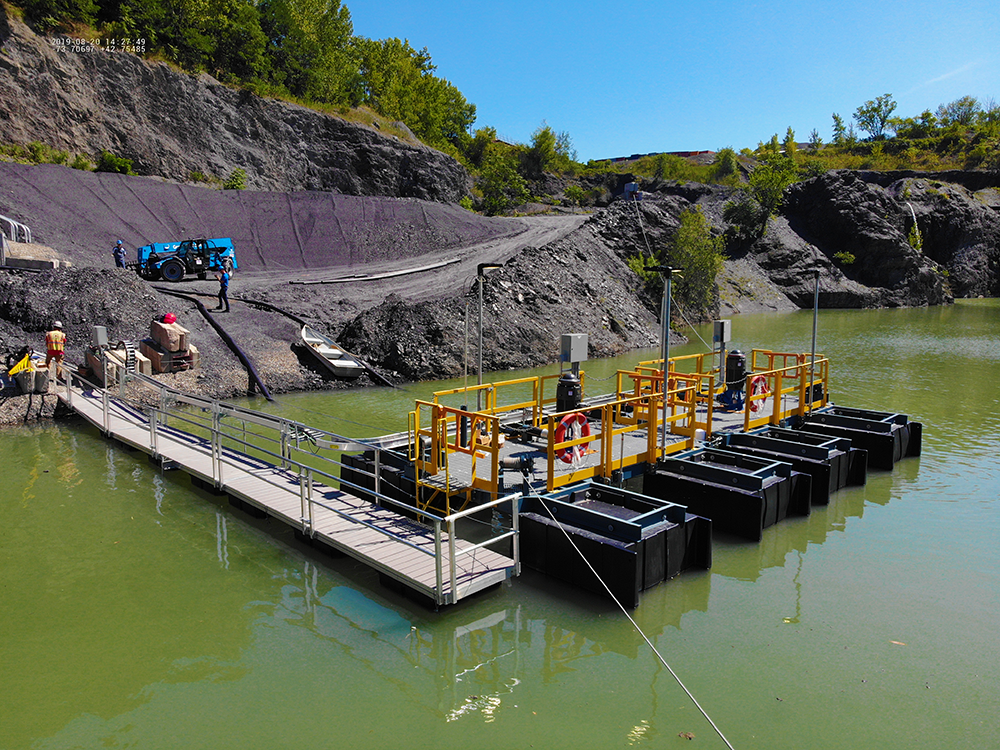
Jones says solutions to resolve accelerated pump wear issues include improving the process water quality to reduce the abrasive solids content in feed water. In the event this is not possible, the best option, he believes, is to replace the installed pump with a pump better able to process increased solids concentrations, such as the Warman DWU pump.
The Warman DWU pump is designed and constructed to handle percentages of abrasive suspended solids in water whilst operating at high-discharge head pressures to transport surface water from dams and ponds on site back to the washing circuit for recycling.
“Water conditions can be unpredictable, and requirements vary by site,” continues Jones. “Key considerations for pump projects include water quality, where pH can range from very low through to high; water content, such as high percentages of abrasive suspended solids and floating debris; equipment loading and other forms of loading such as weather; and pump-priming requirements.”
Using simulation techniques such DEM (discrete element modelling), and working in partnership with marine engineering specialists, Jones says Weir Minerals’ team of experts thoroughly reviews the parameters of each operation to deliver integrated turnkey solutions.
“Multiflo pontoon barge and pump packages are engineered specifically for the environment that the equipment will operate in. These packages include submersible, end-suction centrifugal and vertical turbine pumps to provide a variety of floated and land-based mobile fluid management solutions.
“In addition to a world-leading service and support network, Weir Minerals provides professional on-site training for your personnel to ensure smooth, safe and efficient plant operations and maintenance, creating value for you from day one.”
Jones cites one impressive example, where the team at Weir Minerals designed a fully automated mine dewatering system in Czech Republic. The site had been experiencing poor performance and using a non-automated dewatering pump network where the incumbent pump’s average wear life was just 700 hours. The Weir Minerals solution provided a high degree of reliability as well as low maintenance and spares consumption. The highly engineered concept integrated 127 Warman pumps and multiple Multiflo pontoon barges and has allowed the site to operate for more than two decades without any wet-end spare-part replacement.
Weir Minerals Europe’s dewatering product portfolio includes Warman, GEHO, Floway, and Multiflo pumps designed to transport surface water from dams and ponds on site back to the washing circuit for recycling, as well as Multiflo barge and pumphouse solutions engineered especially for other on-site water sources, such as tailings dams. Jones concludes: “Weir Minerals targets the challenges quarries face with pumping water around site, providing the optimum solution for each specific and unique application.”


